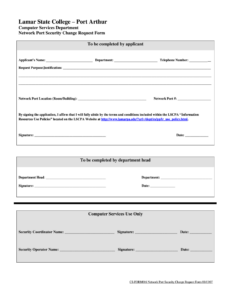Utilizing a standardized form for network security modifications offers several advantages. It minimizes the risk of errors and unauthorized changes, thereby enhancing the overall security posture. A formal review and approval process ensures that changes are vetted by appropriate personnel, reducing the likelihood of security vulnerabilities. Comprehensive documentation facilitates easier troubleshooting and auditing, while clear rollback procedures enable swift remediation in case of problems. This structured approach promotes better communication and collaboration among teams involved in managing network security.
The following sections will delve into the key components of this crucial documentation, best practices for its completion, and strategies for integrating it effectively into existing change management workflows.
Key Components of a Firewall Change Request
Effective management of network security requires meticulous documentation of all proposed modifications. A well-structured request form ensures comprehensive information capture, facilitating informed decision-making and reducing the risk of errors.
1. Requestor Information: Clear identification of the individual or team initiating the request, including contact details, is essential for communication and accountability.
2. Change Description: A concise and unambiguous description of the desired modification is crucial. This should detail the specific rules, ports, or addresses affected by the change.
3. Justification: A clear explanation of the business rationale behind the request is necessary. This justification should demonstrate the necessity and benefit of the change.
4. Impact Assessment: Potential impacts on network performance, security, and connected systems should be carefully evaluated and documented. This assessment should identify any potential risks associated with the change.
5. Implementation Plan: Specific details regarding the implementation process, including timelines, responsible parties, and required resources, are essential for smooth execution.
6. Rollback Plan: A pre-defined plan for reverting the changes in case of unforeseen issues or negative impacts is critical for minimizing disruption.
7. Approval Workflow: Clear identification of the individuals or teams responsible for reviewing and approving the request ensures proper authorization and control.
8. Testing Procedures: Outlined methods for verifying the successful implementation of the change and its adherence to security requirements are essential for validation.
Thorough documentation through these key components ensures transparency, accountability, and reduces the risk of security vulnerabilities. Each element contributes to a comprehensive understanding of the proposed modification, allowing for informed decision-making and controlled implementation.
How to Create a Firewall Change Request Template
Creating a standardized template ensures consistency and completeness in requesting network security modifications. A well-defined template streamlines the process, improves communication, and reduces the risk of errors.
1: Define Required Fields: Begin by identifying the essential information needed for each request. This typically includes requestor details, change description, justification, impact assessment, implementation plan, rollback plan, approval workflow, and testing procedures. Each field should have a clear purpose and provide specific instructions for completion.
2: Choose a Format: Select a format that aligns with organizational practices. Common options include word processing documents, spreadsheets, or dedicated change management software. The chosen format should facilitate easy completion, review, and storage.
3: Structure the Template: Organize the fields logically to guide users through the process. Grouping related information together and using clear headings improves readability and comprehension. Consider using checklists or drop-down menus for standardized options.
4: Establish Clear Instructions: Provide concise and unambiguous instructions for completing each field. This ensures consistency and reduces the likelihood of incomplete or inaccurate requests. Include examples where appropriate to illustrate expected inputs.
5: Implement Version Control: Maintain version control to track revisions and updates to the template. This ensures that the most current version is always in use and facilitates audits.
6: Integrate with Workflows: Integrate the template into existing change management processes. This ensures that firewall change requests follow established procedures and are properly tracked and documented.
7: Train Personnel: Provide training to all personnel involved in submitting or approving firewall change requests. This ensures consistent application of the template and promotes accurate and complete documentation.
A well-designed template, combined with proper training and integration into existing workflows, establishes a robust framework for managing firewall changes. This structured approach strengthens security posture by reducing errors, improving communication, and facilitating compliance.
Effective management of network security relies on rigorous processes for implementing changes. Standardized documentation provides a crucial mechanism for controlling modifications to firewall configurations, ensuring changes are implemented safely and efficiently. Formalized requests, incorporating detailed descriptions, justifications, impact assessments, and rollback plans, minimize risks associated with configuration alterations. Implementing a consistent structure for these requests enhances transparency, facilitates communication between teams, and strengthens overall security posture by reducing the likelihood of errors and unauthorized modifications. Furthermore, meticulous record-keeping supports compliance efforts and provides valuable insights for future security enhancements.
Organizations must prioritize the development and implementation of robust change management procedures, including standardized templates and comprehensive training programs. A proactive approach to network security change management, through the utilization of structured request processes, is not merely a best practice but a critical requirement for maintaining a strong security posture in today’s dynamic threat landscape. Consistent adherence to these practices safeguards sensitive data, ensures business continuity, and builds a foundation for a more resilient and secure network infrastructure.

